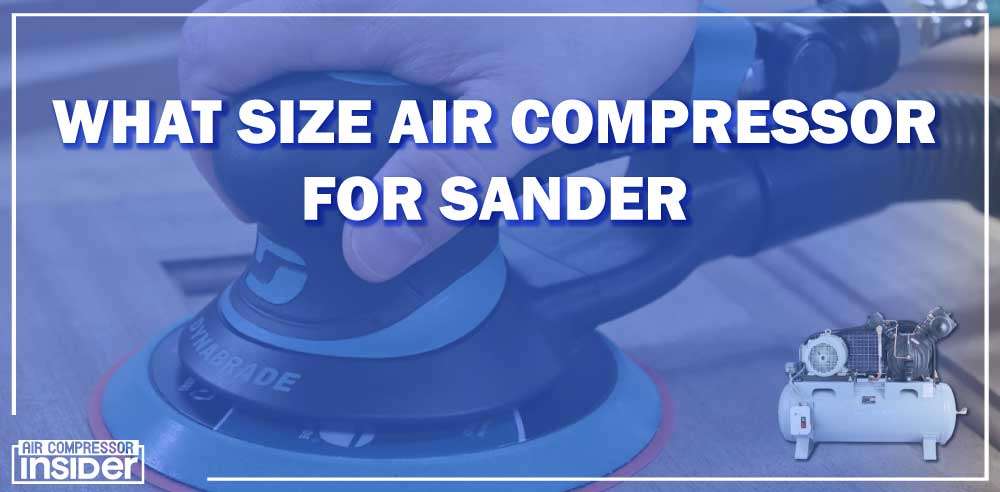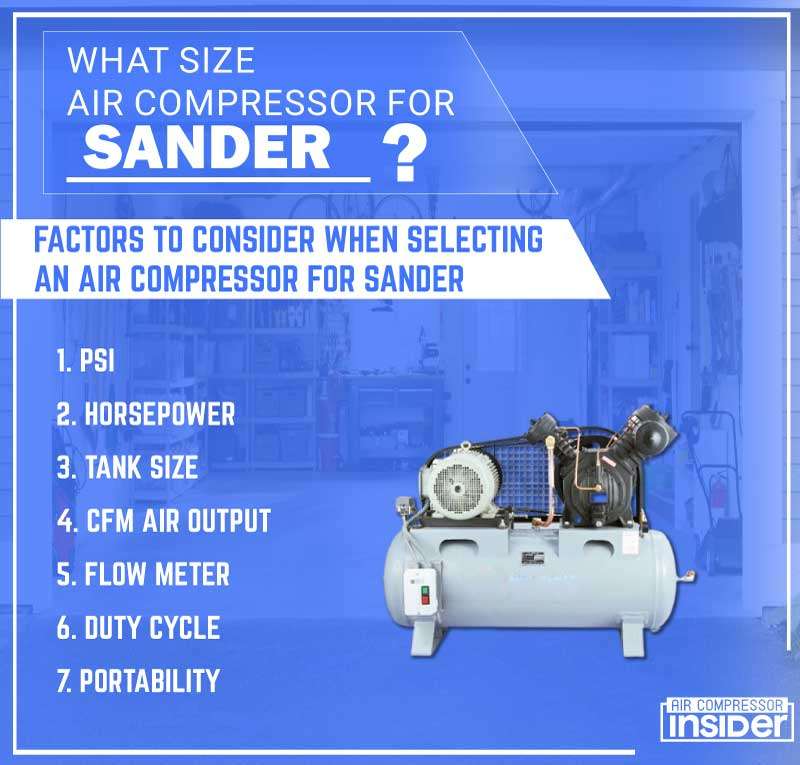Are you a woodworker or metalworker in need of the perfect air compressor for your sander? Trying to find an air compressor that will suit all your needs can be overwhelming, but luckily we’re here to help. The search for an air compressor doesn’t have to be difficult if you know what size air compressor for sander you need.
In this post, we’ll discuss how to choose the best air compressor for your pneumatic sander so that you can get back to work faster with better results. We’ll cover everything from cfm, psi and tank size considerations to choosing the right motor and when it pays off in terms of efficiency and productivity. Keep reading for our complete guide on choosing best air compressor for sanders!
What Size Air Compressor For Sander

For sander, you’ll need an air compressor with a CFM rating of at least 4-6 and a PSI rating around 90. HP should be in the 2-3 range, and the tank size should be around 3-8 gallons or higher.

What Is A Pneumatic Sander?
A pneumatic sander is a type of power tool that is powered by air pressure from a compressor. Typically, these sanders are lighter than electric sanders and require less maintenance due to their simple construction. They are also capable of producing much more torque than an electric sander, making them well-suited for heavy-duty jobs.
The size of the air compressor for your sander will depend on several factors, such as the type and size of sander you use and the kind of job you’re performing. Before buying an air compressor, it is important to understand the needs of your pneumatic sanders so that you can choose the one with the right size and power to suit your needs.
Types of Pneumatic Sanders:
Pneumatic sanders come in a variety of shapes and sizes, each designed for specific uses. Some common types of pneumatic sanders include:
Random Orbit Sanders:
These are ideal for finishing work on large surfaces such as furniture. They provide an even finish with minimal swirl marks.
Palm Sanders:
These are small, lightweight sanders that can be used for light-duty jobs like removing paint or varnish and smoothing wood surfaces.
Belt Sanders:
These are powerful sanders that work quickly for heavy-duty jobs such as shaping woods, removing materials and preparing surfaces for finishing.
Requirements For Random Orbit Sander:
Random orbit sanders require an air compressor that can provide a minimum of 4 cubic feet per minute (CFM) at 90 pounds per square inch (PSI). They also need to have a tank size of at least 6 gallons. For smaller sanders, you may be able to get away with 1-3 gallon tanks, but the larger the tank size, the better for these types of sanders. A two-stage motor is recommended for larger sanders as it will provide more power and a longer running time with less noise and wear.
Requirements For Palm Sander:
Palm sanders are much smaller than random orbit sanders and therefore require much less air pressure. Generally, palm sanders require 2 CFM at 90 PSI with a tank size of 2 gallons or more.
Requirements For Belt Sander:
Belt sanders are some of the most powerful pneumatic tools and therefore require a large amount of air pressure to operate efficiently. These types of sanders require 6 CFM at 90 PSI with a tank size of 10 or more gallons. For these sanders, you should look for a two-stage motor that can provide the necessary power and running time.
7 Important Factors to Consider When Selecting an Air Compressor for Sander:

Once you have determined the type of sander and its intended use, you can begin to consider what size air compressor for the sander will work best. Here are some important factors to keep in mind when selecting an air compressor for your pneumatic sanders:
1. PSI Rate:
The pounds per square inch (psi) rating of an air compressor determines the amount of force it can deliver to the sander. When selecting a compressor for sanding, you will want to make sure that the psi rating is at least as high as the maximum psi rating of your sander.
2. Horsepower:
Horsepower (hp) measures how much power an air compressor can produce. Generally speaking, higher hp ratings equate to faster and more powerful sanders.
3. Tank Size:
Tank size is important because it affects the amount of pressurized air stored in the tank before it must be refilled by your compressor motor. A larger tank means more pressure available for longer periods, making it easier to use power tools like sanders without interruption.
4. CFM Air Output:
Cubic feet per minute (cfm) measures how much air an air compressor can move in a given amount of time. The higher the cfm rating, the more air will be available for your sander.
5. Flow Meter:
A flow meter is a device that measures how much air is flowing through your compressor at any given time. This allows you to ensure that your sander is getting enough power and prevents it from being overworked.
6. Duty Cycle:
Duty cycle measures how long an air compressor can run before needing to shut off for cooling or restocking pressurized air. Generally speaking, higher duty cycles are better because they allow for longer uninterrupted use of your pneumatic sanders.
7. Portability:
If you plan to use your sander in multiple locations, portability is an important factor. Look for a compressor that is lightweight and easy to move around.
By taking the time to consider all of these factors when selecting an air compressor for sander, you’ll be able to find one that meets all your needs. With the right air compressor, you can enjoy better results with less effort!
Frequently Asked Questions
Question #1
What size compressor do I need for my sander?
The size of the air compressor you need will depend on the type and power of your sander. Generally, sanders require at least 4 CFM at 90 PSI with a tank size of 6 gallons or more.
Question #2
Can I use a single-stage air compressor for my sander?
Yes, a single-stage air compressor can be used with a sander. However, it will not provide the same amount of power and running time as a two-stage motor.
Question #3
What PSI do I need to run my sander?
You will need an air compressor with a PSI rating that is at least as high as the maximum PSI rating of your sander.
Question #4
What HP do I need to run my sander?
Higher hp ratings equate to faster and more powerful sanders, so you should look for an air compressor with at least 2 HP.
Question #5
How big of a tank do I need for my sander?
A larger tank means more pressure available for longer periods, so you should look for an air compressor with a tank size of 10 gallons or more.
Question #6
What CFM rating do I need for my sander?
You should look for an air compressor with a cfm rating that is at least as high as the maximum cfm rating of your sander.
Question #7
Do I need a flow meter?
A flow meter is not necessary, but it can be helpful in ensuring that your sander is getting enough power and preventing it from being overworked.
Question #8
What should I look for in terms of duty cycle?
You should look for an air compressor with a higher duty cycle so that it can run uninterrupted and your sander has enough power to get the job done.
Question #9
Is portability a factor when choosing an air compressor for sander?
If you plan to use your sander in multiple locations, portability is an important factor. Look for a compressor that is lightweight and easy to move around.
Question #10
What other factors should I consider when choosing an air compressor for sanders?
When selecting an air compressor for sanders, you should also take into consideration the cost, noise level, and ease of maintenance. Additionally, you should also ensure that the air compressor is appropriate for the type and power of your sander.
Conclusion:
Knowing what size air compressor for sander can be a daunting task, but it doesn’t have to be. By taking into account factors such as CFM rating, duty cycle, portability and noise level, you can find an air compressor that will suit your needs perfectly. With the proper knowledge and research, you can be sure you’ll find the perfect air compressor for sander.
